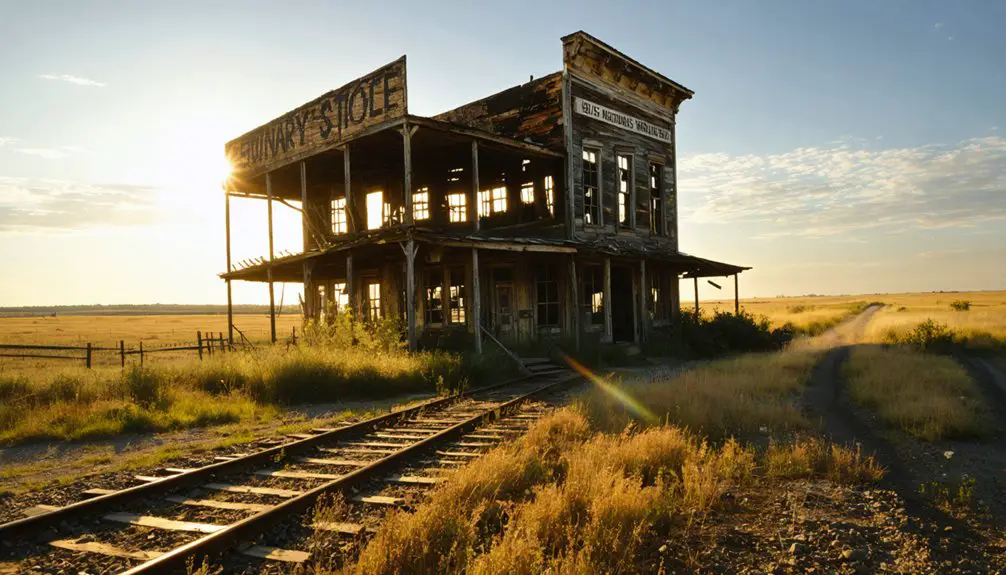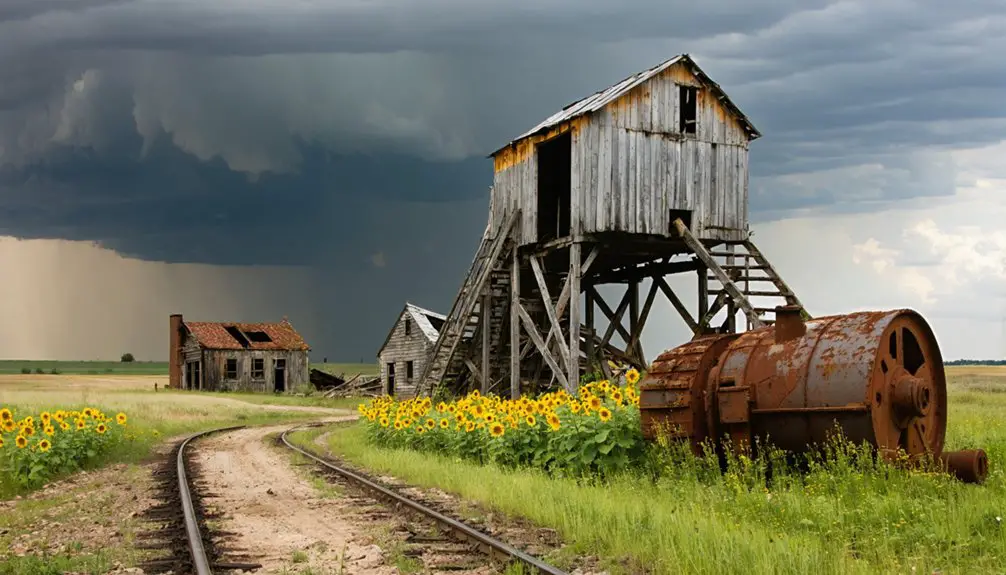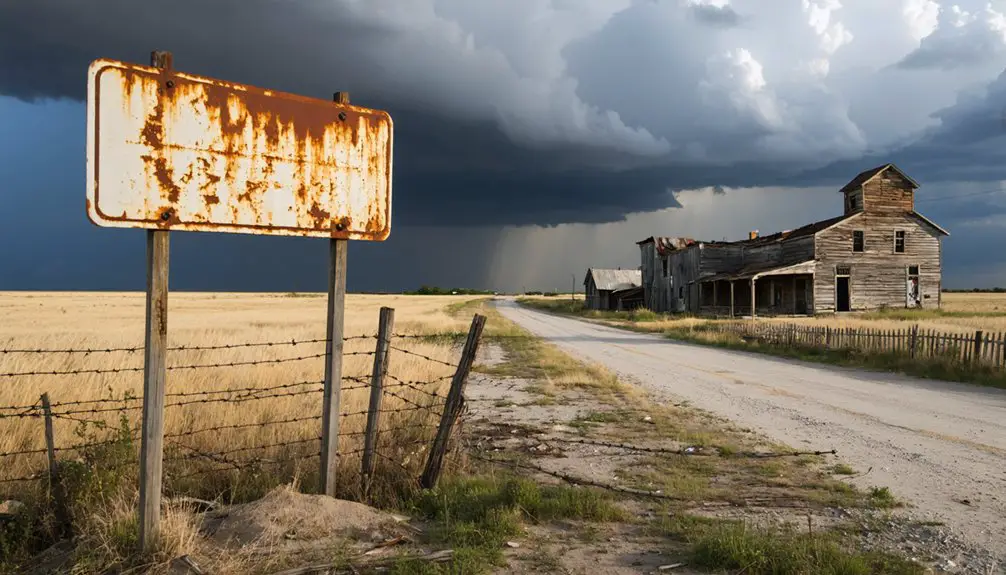You’ll find Empire City’s ghost town remnants absorbed into present-day Galena, Kansas. This once-bustling mining boomtown emerged in 1877 after lead and zinc discoveries, quickly growing to 3,000 residents. The town’s infamous Red Hot Street earned notoriety for gambling and vice, while mining operations supplied 10% of America’s lead production. Though the town declined by 1907, stone foundations, historic buildings, and a large cemetery preserve Empire City’s wild frontier legacy.
Key Takeaways
- Empire City, Kansas was established in 1877 after lead and zinc ore discovery, growing rapidly to 3,000 residents within months.
- The town thrived as a major lead mining center, producing 10% of America’s lead during its peak years from 1918-1941.
- A culture of gambling, saloons, and lawlessness characterized the town, with Red Hot Street being notorious for vice activities.
- The town declined due to Galena’s superior lead fields and depleting ore deposits, leading to absorption into Galena by 1907.
- Today, stone foundations, historic buildings, and a large cemetery remain as tourist attractions near present-day Galena.
The Birth of a Mining Boomtown
When lead and zinc ore was discovered in southeastern Kansas, Empire City emerged rapidly in the spring of 1877 on 120 acres of J. Nichols’ former farmland.
The West Joplin Lead & Zinc Company’s purchase of 700 acres set the stage for ambitious town planning, as they envisioned a thriving company town to rival nearby Galena.
You’ll find that Empire City’s initial development was swift and calculated. Within weeks of selling 200 residential and business lots that May, the town buzzed with construction. The town’s notorious Red Hot Street became a symbol of the lawlessness that characterized the era.
Large multipurpose buildings rose quickly, housing everything from saloons to company offices. This strategic economic rivalry with Galena, just a mile south across Short Creek, drove Empire City’s rapid expansion as both communities vied to become the region’s dominant “Boss Town” in the Southwest mining district. The population exploded to three thousand residents by summer’s end.
Lead Mining and Economic Growth
As Empire City‘s mining operations expanded in the late 1870s, the lead and zinc industry transformed the region into a powerhouse that would eventually supply 10% of America’s lead production.
You’d find over 11,000 miners working throughout the Tri-State district during peak years between 1918 and 1941, with countless others employed in supporting roles.
Companies like West Joplin Lead & Zinc Company revolutionized operations by purchasing vast tracts of land and implementing mechanized exploration methods.
They’d drill thousands of holes and prospect shafts to locate ore deposits in the Mississippian limestone formations.
The arrival of the St. Louis-San Francisco Railway and establishment of local smelters created new economic opportunities, while mining activity spurred the growth of company towns, commercial buildings, and essential services throughout Empire City.
The Cherokee Group shales acted as natural barriers that prevented metal-bearing solutions from escaping the ore-rich limestone beds.
Life on Red Hot Street
The notorious Red Hot Street marked a stark contrast to Empire City’s industrial mining prosperity. You’d find yourself in a bustling thoroughfare where gambling, drinking, and vice culture dominated the landscape.
Street activities included open gambling on sidewalks, while saloons, brothels, and dance halls pushed legitimate businesses away from the area. Like Coffeyville’s own notorious street scene, the area attracted dangerous characters and criminal elements.
If you’d ventured here during its peak, you’d witness a volatile mix of miners, gamblers, and other thrill-seekers engaged in what observers called unmatched revelry. Law enforcement had little control, creating a lawless atmosphere that fueled social tension between Empire City and neighboring Galena.
The economic impact was significant – while vice-centered trades flourished, respectable commerce retreated to other areas. The tension reached such heights that a wooden stockade barrier was built in 1877 to prevent movement between the rival towns. The street’s reputation ultimately contributed to Empire City’s decline and eventual absorption into Galena.
The Galena-Empire City Feud
During the late 1870s, fierce rivalry erupted between Empire City and neighboring Galena as both towns vied for dominance in the region’s lucrative lead mining industry.
Lead mining sparked an intense battle for economic supremacy between Empire City and Galena during the 1870s boom years.
Empire City initially attracted more settlers due to its proximity to mining operations.
The feud dynamics intensified when Empire City’s council erected an eight-foot-high stockade in July 1877, attempting to block residents from moving to Galena and restrict commerce flow.
West Joplin Lead & Zinc Company’s 120-acre purchase in 1877 sparked rapid development that fueled Empire City’s competitive spirit.
You’ll find this economic rivalry reached its climax on August 15, 1877, when Galena’s mayor led a 50-person posse to tear down and burn the barrier at 4 a.m. While minimal gunfire occurred, the incident symbolized Empire City’s failed attempt to isolate its rival.
Despite Empire’s strategic efforts to control trade and mining-related business, Galena’s superior lead fields ultimately made their victory inevitable.
Rise and Fall of the Mining Era
Lead and zinc discoveries in 1877 transformed Empire City from empty prairie into a bustling mining hub, drawing hundreds of prospectors and investors to the region.
As mining technology advanced, the West Joplin Lead & Zinc Company established operations, creating a company town where your position in the social hierarchy depended on your role in the mines.
The region’s zinc and lead production between 1886 and 1901 generated an impressive $19 million in total value.
You’d have witnessed immigrants flocking to Empire City, bringing their cultures and dreams of prosperity.
Like the coal fields near Carbondale, Empire City’s mines drove significant industrial growth and economic development in the region.
The boom years brought wealth, jobs, and infrastructure development, but they wouldn’t last forever.
By the late 1800s, neighboring Galena’s dominance in the district, combined with depleting ore deposits and fluctuating market demands, spelled trouble for Empire City.
The once-thriving mining community gradually declined as miners and their families sought opportunities elsewhere.
What Remains Today
Visitors to Empire City today will find a haunting collection of late 19th-century structures scattered across the Kansas prairie.
You’ll discover several historic homes and business buildings that have weathered decades of abandonment, including remnants of the once-bustling “Red Hot Street” with its notorious saloons and gambling halls.
Though the railroad tracks have largely vanished and streets have surrendered to nature, the remaining structures and historical artifacts tell tales of the town’s wild past. Like many Kansas ghost towns that lost their primary industries, Empire City gradually declined until most residents were forced to relocate.
While a handful of people still occupy some homes in this “living ghost town,” most buildings stand empty and deteriorating.
You’ll need to watch your step as you explore – minimal safety measures exist, though that hasn’t deterred ghost town enthusiasts and historians from documenting the silent witnesses to Empire City’s rowdy heyday.
Legacy of a Kansas Mining Town

When you visit the former site of Empire City today, you’ll find few traces of the rapid growth that transformed 120 acres of J. Nichols’ land into a bustling mining town of 3,000 residents by 1878.
The town’s wild character emerged through its numerous saloons and gambling halls, creating a lawless boomtown atmosphere typical of Kansas mining communities in the late 1870s.
Like many mining settlements dependent on finite mineral resources, Empire City’s eventual decline and absorption into Galena by 1907 serves as a reflection of the boom-and-bust cycle of frontier resource extraction.
Mining Drove Initial Growth
Mining transformed Empire City from an ordinary tract of Kansas farmland into a bustling frontier boomtown in 1877.
You’ll find that the West Joplin Lead & Zinc Company purchased 700 acres, quickly selling 200 lots and establishing essential businesses to support the rush of prospectors and miners. The company’s investment sparked rapid development, making Empire City a fierce rival to nearby Galena.
The area’s mining techniques included underground shaft-mining and room-and-pillar methods, with some shallow deposits allowing simple hand-tool extraction.
This accessibility earned the region its “poor man’s mining district” reputation. The economic impact rippled through the community as thousands of mining jobs spurred railroad expansion, new infrastructure, and diverse commercial growth.
You can trace Empire City’s explosive development directly to the mineral wealth beneath its soil.
Lawless Boomtown Culture Thrived
As Empire City‘s population swelled with fortune-seekers in the late 1870s, you’d find a raw frontier culture where lawlessness and opportunity intertwined. The boomtown dynamics created a perfect storm of disorder, with miners, entrepreneurs, and drifters all competing for their share of prosperity.
Without effective law enforcement, violence and vigilante justice became common methods for settling disputes.
- Saloons dominated the social scene, fueling a culture of drinking that often sparked deadly confrontations.
- The transient nature of the mining population made it difficult to establish stable governance.
- The lawlessness legacy lives on in stories of barroom brawls and street shootouts.
The pursuit of quick riches overshadowed concerns about social order, creating an environment where personal freedom often came at the expense of community stability.
You’d witness a town where success and survival depended on your ability to navigate this chaotic landscape.
Ghost Town Today Remains
Though Empire City’s bustling days have long passed, you’ll find tangible remnants of its mining heritage scattered across the Kansas landscape today.
Historic buildings and homes still stand within the former town limits, while stone foundations from mining operations dot the terrain. The large cemetery serves as a silent memorial to the once-thriving community.
You can explore the ghost town tourism offerings near present-day Galena, where historical preservation efforts maintain Empire City’s memory.
While Red Hot Street no longer buzzes with vice and entertainment, you can trace its documented path. Local historians lead tours of the area, sharing stories of the town’s mining legacy.
The site’s proximity to Route 66 makes it an intriguing stop for history enthusiasts seeking to understand Kansas’s boom-and-bust mining era.
Mining Ghost Towns of the Midwest

During the late 19th and early 20th centuries, the American Midwest experienced a dramatic surge in resource-driven settlements, with numerous mining towns sprouting up around newly discovered mineral deposits.
You’ll find that these communities thrived through advanced mining techniques and complex social dynamics, often reaching populations of thousands during their peak years.
- Mining companies built entire towns, complete with housing, schools, and trading posts to support their workers.
- Local economies centered almost exclusively on mineral extraction, making them vulnerable to market shifts.
- Most towns faced abandonment within 30-40 years due to depleted resources or economic downturns.
Michigan’s Upper Peninsula exemplifies this pattern, where copper mining towns boomed and busted, leaving behind countless abandoned structures.
Today, these ghost towns serve as powerful reminders of the region’s resource-driven past and the temporary nature of frontier prosperity.
Frequently Asked Questions
What Happened to Empire City’s Post Office After the Town Declined?
You’ll find Empire City’s post office timeline mirrors its community decline – operating from 1877 until 1888, when it closed after being renamed Lone Tree. Services then transferred to nearby Galva.
Were There Any Notable Mining Accidents or Disasters in Empire City?
You’ll find the worst mining disaster near Empire City occurred at Frontenac’s Mine No. 2 in 1888, where poor mining safety and inadequate dust control led to 44 deaths from an explosion.
What Was the Average Wage of Miners Working in Empire City?
You’d have earned around $6.50-$7.00 per day as a miner in Empire City during the 1920s, with half-month mining wages near $60-$62, before the Great Depression drastically cut your earnings.
Did Any Famous Outlaws or Historical Figures Visit Empire City?
You won’t find documented evidence of famous outlaws or historical figures visiting Empire City, though its wild saloons and gambling halls likely attracted notorious characters during the town’s mining heyday.
What Indigenous Tribes Originally Inhabited the Land Where Empire City Was Built?
Before 1,000+ settlers arrived, you’d have found the Kanza (Kaw) and Osage tribes sharing this land, with the Kanza primarily occupying the area where Empire City would later stand.
References
- https://www.legendsofamerica.com/ks-empirecity/
- https://www.hhhistory.com/2019/05/ghost-towns-of-kansas.html
- https://www.youtube.com/watch?v=alC1wDdSVvg
- https://legendsofkansas.com/kansas-ghost-town-list/
- https://www.legendsofamerica.com/ks-ghosttowns/
- https://galenaks.gov/directory/galena-mining-historical-museum/
- https://joplintimecapsule.org/nearby/
- https://www.legendsofamerica.com/ks-galena/
- https://kgs.ku.edu/lead-and-zinc-mining-kansas
- https://share.mo.gov/nr/mgs/MGSData/Books/Special Publications/Geologic Field Trips in the Greater Kansas City Area (Western Missouri



